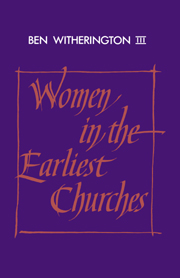Book contents
- Frontmatter
- Contents
- Preface
- Abbreviations
- Introduction
- 1 Women in first-century Mediterranean cultures
- 2 Women and the physical family in the Pauline epistles
- 3 Women and the family of faith in the Pauline epistles
- 4 Women and the Third Evangelist
- 5 Women in the churches of Matthew, Mark, and John
- 6 Trajectories beyond the New Testament era
- Conclusions
- Notes
- Bibliography
- Frontmatter
- Contents
- Preface
- Abbreviations
- Introduction
- 1 Women in first-century Mediterranean cultures
- 2 Women and the physical family in the Pauline epistles
- 3 Women and the family of faith in the Pauline epistles
- 4 Women and the Third Evangelist
- 5 Women in the churches of Matthew, Mark, and John
- 6 Trajectories beyond the New Testament era
- Conclusions
- Notes
- Bibliography
Summary
My previous monograph, Women in the Ministry of Jesus, concentrated on one particular kind of material in the New Testament, i.e., that which may well go back to the Sitz im Leben Jesu. This volume seeks to take the next step by looking at texts which give us clues about women and their roles in the earliest post-Easter communities. In order to have some sort of historical perspective, we will attempt to look at the relevant texts in what may roughly be called chronological order, realizing that the dates for various of the New Testament books are debatable. Thus, after the necessary background chapter we will deal with the Pauline material, including the Pastorals. Then we will examine the perspectives of the evangelists about women and their roles. In the concluding chapter we will move beyond the canonical period to glimpse how the various trends and trajectories of the New Testament period were followed or abandoned during the age of the ante-Nicene Fathers.
At this point it may be worthwhile to explain this book's raison d'être. In reading through the ever-growing literature dealing with women in the Bible, one is constantly confronted with able scholars who nonetheless come to the text with a specific agenda in mind, whether patriarchal or feminist. This is not surprising in view of the importance of the issue, but when the Bible is used to justify positions which are polar opposites one suspects that something has gone awry.
- Type
- Chapter
- Information
- Women in the Earliest Churches , pp. 1 - 4Publisher: Cambridge University PressPrint publication year: 1988

